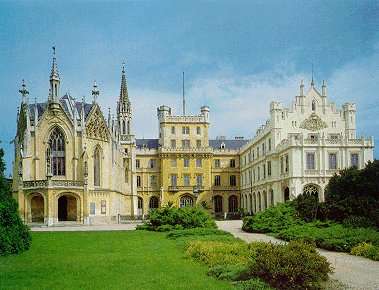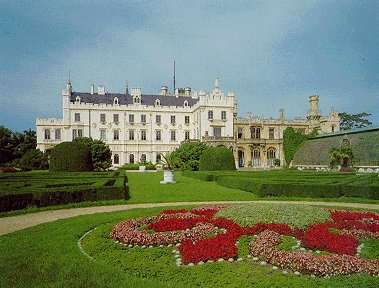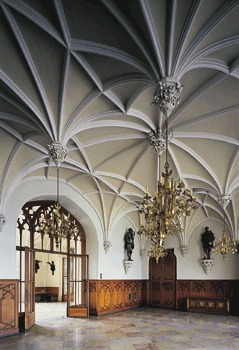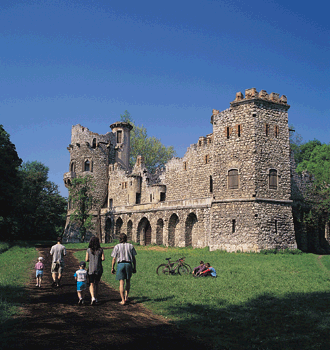


| TSD 2002 Proceedings | O | Invited Speakers | O | TSD 2002 Program | O | Conference Trip | O | Available Equipment | 
|

The Wednesday afternoon of the conference is reserved for a trip to the South Moravian region Lednice - Valtice. We will see the chateau at Lednice with its large botanical gardens and beautiful surroundings.
In the evening there will be the conference dinner in the famous wine cellar in Valtice chateau, where a traditional cembalon band will play.
 Between Bĝeclav, the Neo-Gothic chateau Lednice and Baroque residence in Valtice,
lies a charming world of parks, gardens, ponds and forests, complemented by a number
of small structures ranging from hunting lodges, chapels and colonnades, and up to
the minaret and imitation castle ruins. The Lords of Liechtenstein, who were once
the owners of the Lednice chateau estate, created the largest ever composed landscape
area, rightfully listed in the UNESCO World Index of Cultural and Natural Heritage.
Between Bĝeclav, the Neo-Gothic chateau Lednice and Baroque residence in Valtice,
lies a charming world of parks, gardens, ponds and forests, complemented by a number
of small structures ranging from hunting lodges, chapels and colonnades, and up to
the minaret and imitation castle ruins. The Lords of Liechtenstein, who were once
the owners of the Lednice chateau estate, created the largest ever composed landscape
area, rightfully listed in the UNESCO World Index of Cultural and Natural Heritage.
Although it has a long history behind it, the South Moravian castle of Lednice surrounded by an extensive English park, displays a typical architecture of the Romantic period.
The castle began as a fortress first mentioned in 1222, which occupied a strategic
position in the frontier zone of the locale. In 1544 - 88 the stronghold was
transformed into a Renaissance chateau with a garden by Hartman of Lichenstein.
 The late 17th century brought further alterations, including the enormous riding
school and stables erected to the plans of Johann B. Fischer of Erlach. Evidently,
it was their rise to the rank of Princes of the Empire that impelled the Lichensteins
to undertake such ambitious works. In 1766 - 1822 the new classicizing tastes helped
refashion the buildings.
The late 17th century brought further alterations, including the enormous riding
school and stables erected to the plans of Johann B. Fischer of Erlach. Evidently,
it was their rise to the rank of Princes of the Empire that impelled the Lichensteins
to undertake such ambitious works. In 1766 - 1822 the new classicizing tastes helped
refashion the buildings.
In 1815 the Empire style followed the designs of J. Kornhausel. However, not even this stage satisfied for long the Lichtenstein demands, which now turned to the neo-Gothic fashion. The new trend was imposed on the castle in 1846 - 58, first by the designs of Georg Wingelmüller and finally by Johann Heidrich. The interior also turned neo-Gothic, as we can see form the many halls enriched with carved wooden ceilings, staircases, and furniture.
The garden, too, underwent these changes of style. The last phase, dating from the 1840's, is the work of the architect, Fanti, and the botanist, Richard van der Schott, who transformed a flower garden "a la francais" into an English park of the Romantic period. Conceived in the grand manner, the park includes many structural features such as, for example, the cast - iron frame to the greenhouses built by the Englishman, P. H. Desvignes in 1843, the Temple of Apollo dating from 1817, the Romantic ruins of a castle built by Josef Hardmuth in 1807 and the Temple of the Three Graces dated 1825.
Additional information about the Lednice - Valtice areal can be found at the UNESCO pages or at the Lednice - tourist information pages (in czech only).



| 
| 
|